Why creating a stupa and other shrines.
Building Buddhist monuments such as temples, pagodas, shrines and stupas at Bagan and elsewhere? It was fashion for centuries to build them as an insurance against the risk inherent in bad actions. The whole area at this ancient city for kilometers and kilometers was and is a maze of them.
Everyone who could afford it built Buddhist stupas, shrines, temples and pagodas and dedicated slaves to keep them.This pagoda-building was well suited to a rich and elegant environment.
Every building had flavor of arts, building one was profitable, not in a vulgar sense, but metaphysically. The profit was connected with the current theory of salvation by works, a theory which mystics like the Royal Chaplain found shallow, but which was suitable for laymen. According to it all actions were indestructible facts which accumulated, became the personality of the actor.
In the Buddhist world to build a stupa or temple was assumed to be a meritorious act and, therefore, to make the builder to that extent a "meritorious person". It balanced unmeritorious acts, means, if a court lady felt that her tongue had been running away with her and thereby she was accumulating a demerit which threatened to hold her back from that ultimate enlightenment which was the aim of the religion, it became very proper for her to build a pagoda.
The whole area in this ancient city for "kilometers and kilometers" was and is a maze of Buddhist temples. Everyone who could afford it made one and dedicated slaves to keep them in repair.
An average Burmese.
If he had the means, took on himself the responsibility of supporting the Religion. Building Buddhist pagodas and temples, both solid and hollow, monasteries of both bricks and of wood, and others like the alms house, the rest house, the library, the reservoir etc. were taken as contributory towards the long life of the Religion until the end of the 5,000 years after the Mahaparinibbana.

Although Bagan and its environs is full of brick ruins, we gather from the inscriptions that there were more wooden buildings in olden times. Our primary concern here is to recount how these Buddhist stupas and temples were made, as described by the donors themselves.
A person in 1192 selected a site just beside the reservoir at Amana this Temple Buildings and enclosed it with ut-ti piu so tantuin - a wall entirely of bricks, for the construction of a big and pleasant monastery. Another donor spent 10,000 ticals of silver on building a monastery, a hollow-pagoda and a wall around them. An inscription of 1248 mentions that the wall alone cost 432.25 ticals of silver.
It must have been a fairly large enclosure wall as the establishment contained two monasteries, a library and a hollow pagoda with four gates. Some of the enclosure walls were circular but usually they were rectangular or square as they are referred to as tantuin 4 myaknha- four sided walls, complete with tatirkha muk - doors and gateways. These enclosures are essential not only to distinguish a holy Buddhist place from its surroundings but also to protect the temples from fire.
Sometimes a Banyan tree which had been grown from a seed imported from the sacred place in India would be planted. It was very popular do get them from Bodh Gaya it would be enclosed in a magnificent wall There were also walls made from stone.
 Within the waof a hollow or solid-pagoda, although there were exceptions when it was made as a promenade to an adjoining monastery since walking to and fro seems to be the only physical exercise befitting a gentle monk. Asawat's wife, a staunch Buddhist when temples and some shrines attached to her monastery in 1236, said that she used bricks from two kilns at the cost of 60 ticals of silver in addition to 22 ticals for caning themll a platform, was made as the foundation
Within the waof a hollow or solid-pagoda, although there were exceptions when it was made as a promenade to an adjoining monastery since walking to and fro seems to be the only physical exercise befitting a gentle monk. Asawat's wife, a staunch Buddhist when temples and some shrines attached to her monastery in 1236, said that she used bricks from two kilns at the cost of 60 ticals of silver in addition to 22 ticals for caning themll a platform, was made as the foundation .
For bringing in timber, probably for roofing, she spent 6 ticals more. in the case of a platform for a hollow-pagoda, we have several instances where it is mentioned that the platform is made in the shape of a kalaka pot. Perhaps this refers to the plinth molding of the platform wall.
On such a Pagoda platform was built a ka, which is derivative of Pali guha meaning a cave, and therefore it is a hollow-pagoda made in imitation of a natural cave. Some had four gateways and thus acquired the name ket 4 myaknha Inside a four sided ka there were always four images of the Lords placed back-to-back in the centre, representing the four Buddhas of
this present kappa. The central block, around which the images wem placed, was the relic chamber where sariradhitu- the bodily relics, were enshrined. The walls of the ka would be painted either with khlyu pan - floral designs, or charrpu- pictures of the Lord or with scenes from the Jataka.
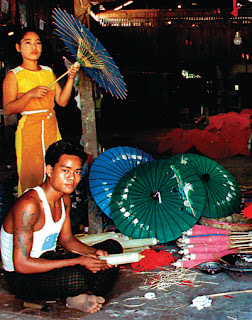
One record says that as many as 14,619 Buddhas were painted on the wall. A ka thus painted would be known as ka prok -the variegated cave. Athwat - the spires, of these ka were usually made from copper and gilded. Above the athwat were the MT - umbrellas, sometimes made of donated gold and studded with gems.
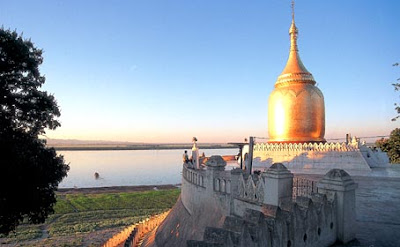 |
| At the Irrawaddy River |
A ceti is another form of pagoda, but solid in structure to build one a ceti, firstly a platform would be made in much the same manner as for erection of a ka. The following extract from an inscription dated 1227 gives a rough idea of what son of relics were enshrined.
Author Professor Than Tun.
Sacred monuments and shrines in Bagan. |
|
 |
| Countless Pagodas & Temples at sunset |
There are much more temples than pagodas but the fact is that most religious edifices are a combination of both. That means the first is the base and on top is the other, its a pragmatic approach.
 |
| Balloons over the city |
The Shwezigon Pagoda is a sacred monument as usual in the Buddhist world and it is a real impressive one. There are several monumental structures with a Hindu touch, actually comparing them to the Vatican, the Mosques of Mecca and Medina, the new ones of Putrajaya in Malaysia or elsewhere, they are no match to the sacred structures here.
Walk into a Buddha shrine
Here the "Nanpaya Temple"
there is a spacious interior often decorated with mural paintings and Buddha statues. The place is close to the Manuha shrine.
According to tradition, it was used as the residence of the captive Mon king, Manuha. It is built of brick and mud mortar and surfaced with stone and is square in plan with a porch projecting on the east face.
Flanking the sanctuary in the main building are four stone pillars on the sides of each of which are carved triangular floral designs and the figures of the Brahma holding lotus flowers in each hands seen in the picture on the left side.
|
|
Like other buildings this one has perforated stone windows to admit light into. The arch pediments over the windows and the carvings of the frieze are fine examples of architectural motifs in stone.
Murals or wall paintings in the temple.
The pictures depict the time when the place was built beside of the usual Buddha Art. Its a great showcase to find out what was going on about one thousand years or more. As a normal tourist it's impossible to see all this because the people at the administration who overlook all this wont let anyone to have a look unless a substantial amount of money change hand.Since this people all work according to the communist schedule, "we pretend to pay you a good salary and you pretend a good work" but both never actually happen.
Most fascinating places. |
Mural paintings are covering walls and ceilings in great color and are sometimes more than thousand years old and different topics are included in the pictures with obvious influences from other religions like Christianity and Islam read more.
People tell legends of around two thousand monuments around but that can hardly be true. Myanmar's are somehow very similar to Thai they always accurate everything extremly making out an elephant from a fly when it is convenient.
The Bupaya Pagoda at the banks of the Irrawaddy standing at the banks of the waterway, the dome resembles a cylindrical relic casket, there are some indications that a king with the name Pyusawhti who was the ruler of the city in the third Century had it built. There is a shrine dedicated to the Mondaing Nat, the God of the storms.
The Lokananda Pagoda is very close as are some more of them right at the edge of the stream which was always a preferred place to build good visible structures. Today no more are built although plenty of renovation work is going on.
Now it's time for hotels and resorts, time is shifting from a spiritual to material world, how did Madonna sing about the material girl? It's dollars no other stuff interests the people anymore, the gods and spirits can wait we have some business to do, here and now.
The Thatbyinnyu Temple
Thatbyinnyu Temple signifies "omniscience" one of the attributes of the Buddha this monument was built in the middle of the 12th century by King Alaungsithu grandson and successor of the King who created the Ananda Temple read more.
Sinhalese sources, however, indicate that it was the Sinhalese who put the king to death. Most of the arches and the major portion of the structure are still sound. The finest brickwork is to be seen in this temple and the enclosure wall. By cross section this massive Buddhist Monument, the Dhammayangyi Temple is similar to the Ananda, but only the outer corridor is accessible as all the entrances to the inner one are blocked by brickwork for an unknown reason.
The Apayadana Temple
 |
| City Wall |
This was built around 1280 a.d. by King Narathihapati and is known for artful terracotta tiles with jakata stories around the terrace.
Buddhist Pagodas
shwezigon pagoda
A Stupa or Pagoda
bagan-temple
buddha-temple
buddhist-shrine
dhammayangyi-temple
lokananda-pagoda
mingalazedi-pagoda
sacred-monuments
temple-interior


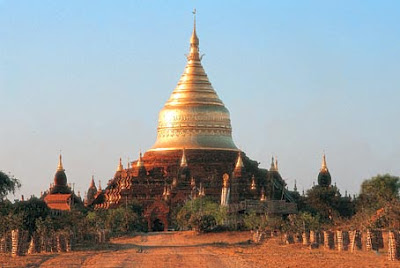











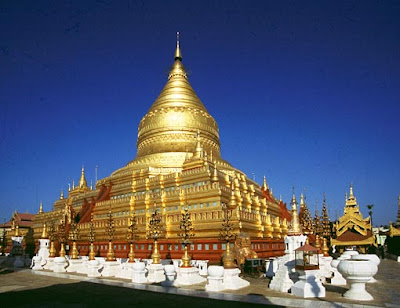


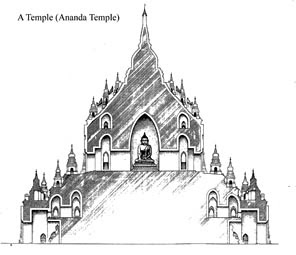
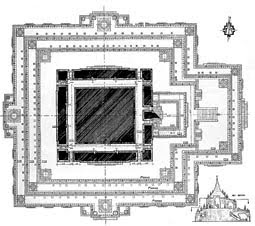





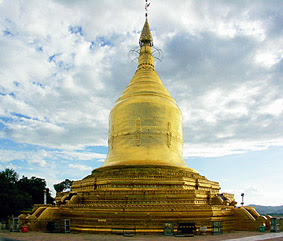
.jpg)






No comments:
Post a Comment